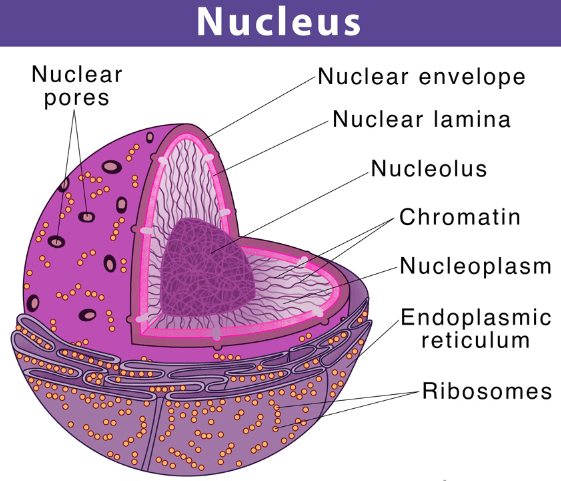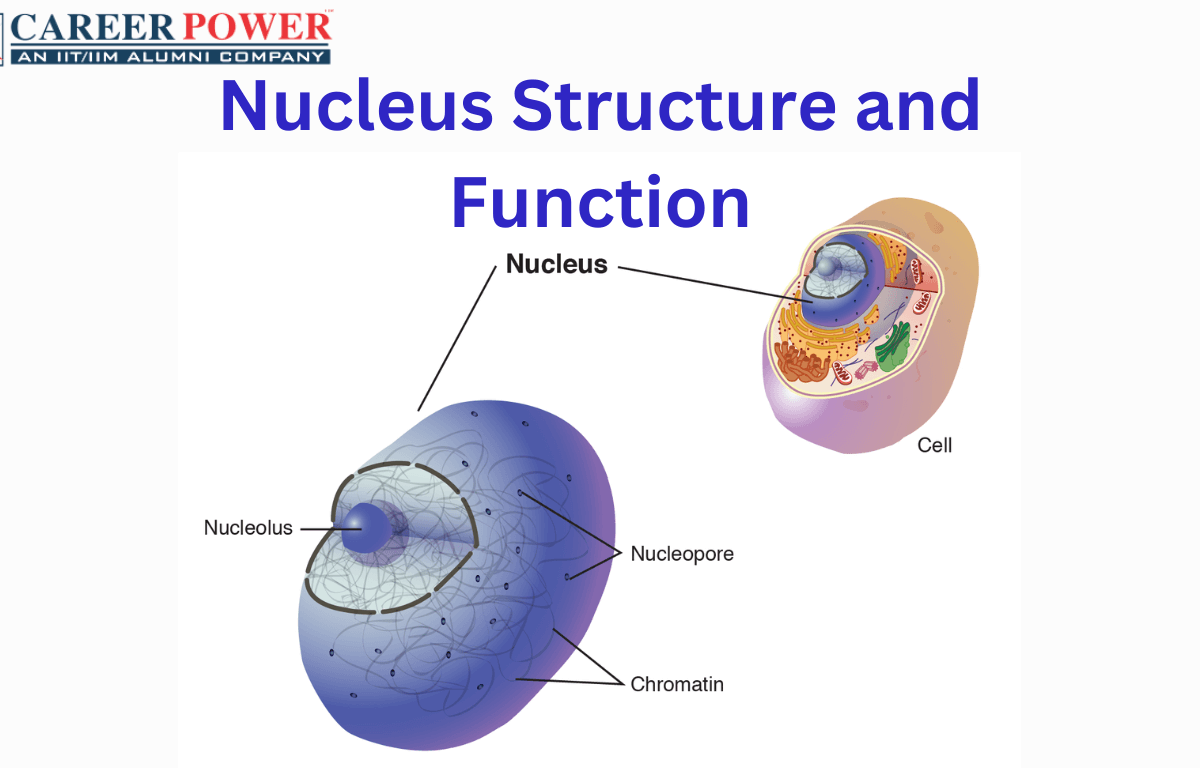Nucleus- Definition, structure & function: As we all know, the cell is the primary and structural, functional, and biological unit of all known living organisms which is the smallest unit of life. Every Eukaryotic cell has a spherical-shaped organelle called the Nucleus, which is often described as the control centre. The nucleus was first discovered by Robert Brown as early as 1831. Its primary function is related to genetic expression and coordination of heredity and genes. The nucleus comprises the nuclear membrane, chromosomes, nucleoplasm, and nucleolus. In every cell, a nucleus accumulates about 10% volume of the cell. In this article we will see more details about the nucleus, its structure and its function.
Nucleus Definition
The nucleus is defined as the double-membraned eukaryotic cell organelle that functions as the control centre of the cell and contains genetic material. The most integral component of every cell is the nucleus, the plural of which is nuclei derived from the Greek word meaning ‘Kernel of a nut’. It is the central part of the cell, that contains chromosomes.
Structure of the Nucleus
The nucleus occupies about 10% volume of cells, which is a spherical or oblong structure. The average diameter of the Nucleus in Mammalian cells is nearly 6 µm. It can be easily identified through light microscopy. Nucleus colour is usually greyish but may differ depending on the type of cell.
Nucleus Diagram

The structure of the nucleus is composed of the following:
- The nucleus is surrounded by a thick nuclear membrane called the Nuclear Envelope and comprises of Nucleolus, Nucleoplasm and chromosomes.
- The Nuclear Envelope separates the constituents of the nucleus from the cytoplasm of the cell and gives a shape to the nucleus. It is made up of phospholipids that form a lipid bilayer. It has small nuclear pores through which molecules flow in and out of the nucleus.
- Nucleoplasm, also called karyoplasm is the matrix present inside the nucleus. This maintains the rigidity and serves as a suspending substance for the genetic material of the cell.
- The nucleolus is found inside the nucleus and helps in protein synthesis by synthesizing ribosomes.
Parts of the Nucleus
Every Eukaryotic cell has a Nucleus and every Nucleus has the following parts as described below:
Nuclear Membrane:
- The thick double membrane envelope of the nucleus is the nuclear membrane or nuclear envelope.
- The outer layer of the nuclear envelope is connected with the Endoplasmic reticulum, and the internal compartment of the nuclear envelope is continuous with the lumen of ER.
- The nuclear membrane is composed of lipoproteins, perinuclear space, pores, annuli material, and an inner dense lamella.
- The pores aid in the exchange of larger molecules in and out of the nucleus and cytoplasm.
Chromatin Threads or Nuclear Reticulum:
- These are thread-like structures, that are made up of DNA and histones proteins are chromatids.
- The chromatids together form a dense network called chromatin reticulum.
- During cell division, the chromatids become isolated and become condensed, into smaller units called chromosomes.
- Chromosomes are comprised mainly of Nucleic acids called DNA and RNA which contain sugar, nitrogenous bases, phosphate, and is a very complex organic acid.
Nucleoplasm or Karyoplasm
- Nucleoplasm is basically the nuclear sap, which is a homogenous, transparent and colloidal liquid that is surrounded by the nuclear membrane.
- Some of the organic and inorganic nucleic acids, ribose sugar, minerals, enzymes, nucleotides and proteins suspense in the nuclear sap.
Nucleolus
- The very minute, spherical-shaped structures are found inside the nucleus. Some eukaryotes have more than one nucleoli.
- The nucleolus aids in the synthesis of ribosomes that are involved in protein synthesis.
- During cell division, the nucleus disappears and forms again after the generation of new cells after cell division.
Function of Nucleus
The nucleus performs many vital functions in our body and they are majorly responsible for the expression of genes from generation to generation and control the hereditary characteristics. Apart from this, they also aid in protein synthesis, cell growth, cell division, and differentiation. The major functions of the nucleus are highlighted in the pointers below:
- It aids in controlling and regulating the hereditary traits of an organism. Chromatin and chromosomes play a major role in gene expression.
- The nucleus also facilitates DNA replication, RNA transcription and synthesis of many enzymes.
- It also functions in the production of smaller organelles such as Nucleolus and Ribosomes to aid in protein synthesis.
- The nucleus also functions in the transportation of many regulatory factors and energy molecules through smaller pores present in the nuclear membrane.



 50 Vegetables Name for Kids in English a...
50 Vegetables Name for Kids in English a...
 Food Chain: Definition, Types, Examples,...
Food Chain: Definition, Types, Examples,...
 Human Respiratory System: Definition, Di...
Human Respiratory System: Definition, Di...













